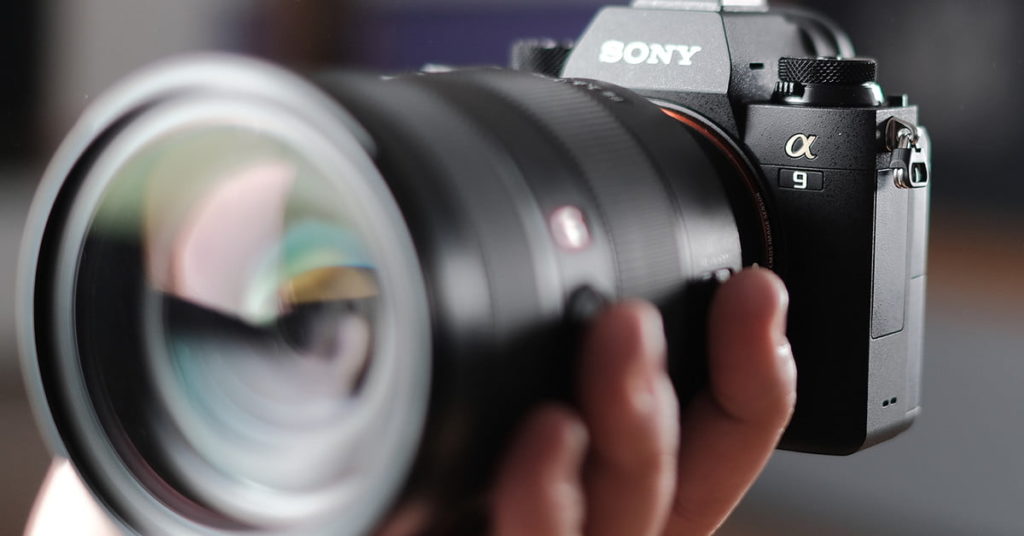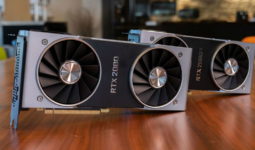The Best Mirrorless Cameras
 Ten years ago, the first mirrorless cameras started hitting the market. They delivered the flexibility of an interchangeable lens system, but in a more compact form factor compared to DSLRs. Unfortunately, the early generations lagged behind their DSLR cousins, hindered by performance issues like slow autofocus and poor battery life.
Ten years ago, the first mirrorless cameras started hitting the market. They delivered the flexibility of an interchangeable lens system, but in a more compact form factor compared to DSLRs. Unfortunately, the early generations lagged behind their DSLR cousins, hindered by performance issues like slow autofocus and poor battery life.
Fast-forward to 2018, and mirrorless cameras have changed the game. Not only are they as strong as DSLRs, but if you look at certain reports, they are outperforming them in sales as well. For you, this means there are far more appealing options than before. Whether you’re looking for something that’s capable enough for studio work or compact enough for travel, many models will fit the bill. Here are our current favorites for best mirrorless camera in a number of categories.
The Nikon Z Series won our award for the best products of the year. Make sure and check out all our other selections for Best Products of 2018.
At a glance
Nikon Z6
The best
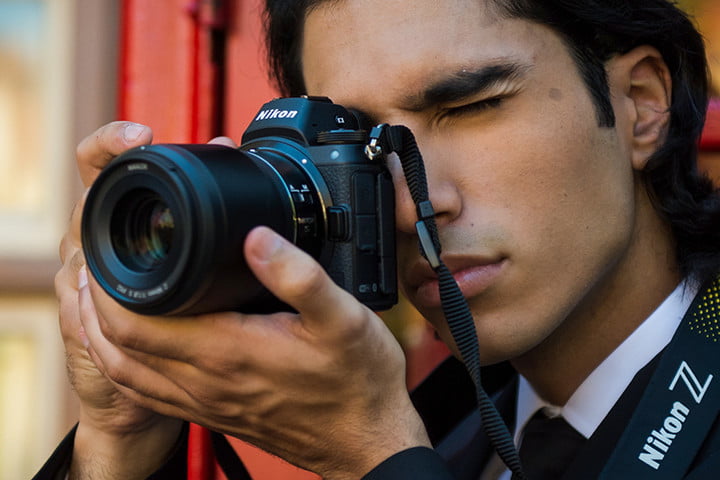
Why should you buy this: Full-frame image quality with DSLR-like handling
Who’s it for: Professional and enthusiast photographers, particularly those that already have some Nikon lenses
How much will it cost: $2,000 (body only)
Why we picked the Nikon Z6:
The Nikon Z6 is the mirrorless camera for the DSLR hold-outs. While smaller than Nikon’s full-frame DSLRs, the grip (and menu system) feels very much like a DSLR. With professional level weather-sealing, the Z6 is an incredibly well-made camera. While we haven’t always been fans of the early electronic viewfinder, the EVF on the Z6 is big and high resolution, while offering numerous advantages over an optical viewfinder, like focus peaking and an accurate exposure preview.
The Z6 sports a 24.5-megapixel sensor that’s better in low light than the 45MP. Mixed with the 5-axis in-body stabilization, the Z6 delivers impressive low light results — and can even outperform Nikon’s full-frame DSLRs at high ISOs. Colors are what we’d expect from a Nikon and the new Z lenses are very sharp. The Z6 and Z7 also make serious gains in video, including 10-bit 4:2:2 N-Log to an external recorder, something even Sony’s third-generation mirrorless cameras don’t have.
The Z6 also uses a 273-point hybrid autofocus system that, alongside the Z7, is the first on-chip phase-detection autofocus that Nikon has ever done. There’s still room for improvement, particularly when focusing in low light, but continuous autofocus is available even at the maximum 12-frame-per-second continuous shooting speed.
If the Z6 was Nikon’s third or fourth attempt at making a pro-level mirrorless, it would be less impressive. But if the Z6 and Z7 is what Nikon can do with their first try, then we can’t wait to see what else is in store for the Z series. More than any other camera, the Z6 has finally given Sony some real competition in the full-frame mirrorless game.
Read our Nikon Z6 review
Sony A7 III
The best full-frame mirrorless camera

Why should you buy this: While Sony calls this their basic camera, the performance is anything but.
Who’s it for: Pros and enthusiasts who want both portability, performance and full-frame
How much will it cost: $2,000 (body only)
Why we picked the Sony A7 III:
The Sony a7 line has long been a mirrorless favorite — and the 7 III mixes some of the best qualities from the series. With the low light performance of the A7S II, the dynamic range of the A7R III, and some of the a9’s blazing speed, the A7 III is plenty of camera for many photographers, and yet it’s one of the least expensive in the series.
The A7 III sports a backlit 24-megapixel sensor that delivers impressive image quality, even as the ISO creeps up. Even more impressive is the dynamic range, which helps keep more of the details in the shadows and highlights intact. That five-axis stabilization system doesn’t hurt either. The 4K video is solid, with a plethora of customizable options for adjusting the look of the picture, but it lacks 10-bit output.
Sony has had time to fine-tune the A7 the third generation is a refined, high-end product. Autofocus is quick to lock on, the 10-fps burst rate holds for 40 RAW files, and the battery life — at over 700 exposures — is the best we’ve seen in mirrorless.
The control scheme isn’t our favorite, and many competing cameras offer higher resolution viewfinders. But, the Sony A7 III offers plenty of features for the price point, with image quality that really can’t be beat — unless you need more resolution. If you need more resolution, the Sony a7R III has it — but you get a lot of camera for the $2,000 body-only list price.
Read our Sony A7 III hands-on review
Sony A9
The best for fast action

Why should you buy this: Full-frame image quality meets phenomenal speed and performance
Who’s it for: Professional and enthusiast photographers who want a camera that won’t miss a millisecond
How much will it cost: $4,500 (body only)
Why we picked the Sony A9:
Mirrorless cameras, in theory, can be faster than DSLRs. Without that mirror, there are fewer parts to move to take a single picture. The Sony A9 is the first to truly put theory into practice. It can run laps around other full-frame cameras on the market, thanks to a 20-frames-per-second burst speed and a 693-point autofocus system.
The A9’s speed is due in part to a stacked sensor, with one layer for pixels, one layer to read those pixels, and a third layer that serves as short-term memory for those pixels. While Sony has launched stacked sensor cameras before, the A9 is the first full-frame model to adopt the technology. Its 24-megapixel resolution won’t match the A7R III (at 42MP) for detail, but its faster performance makes it a much better option for sports and action photographers.
While the speed and the quality represent an incredible feat of engineering, the A9 rolls in a number of extras. The electronic viewfinder doesn’t black out while the camera is shooting — even at 20 fps — and the camera can operate completely silently when you want it to, thanks to an electronic shutter. Oh, and because shooting 20 images in 1 second is going to take up a lot of memory, Sony included dual SD card slots, too.
The Sony A9 isn’t exactly perfect — there are fewer lens choices than a Canon or Nikon, and there’s that $4,500 price tag — but when it comes to the camera that’s bringing the most innovation to pro-level photography, the A9 is the one to beat.
Read our Sony A9 hands-on review
Fujifilm X-T3
The best APS-C mirrorless camera
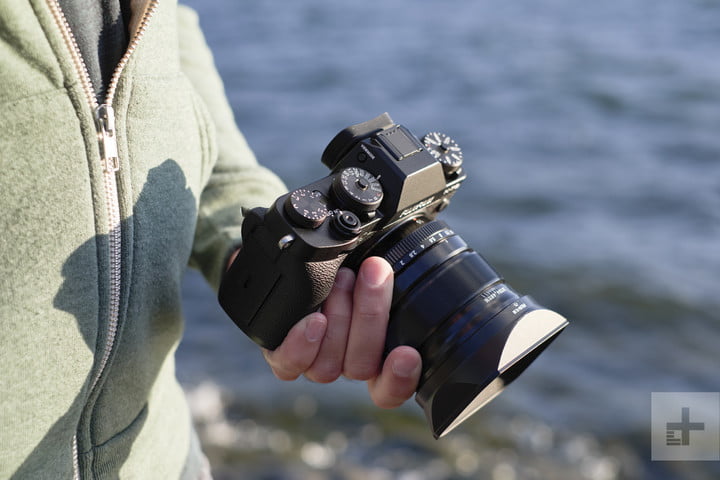
Why should you buy this: Great image and video quality without going full frame
Who’s it for: Photographers who want beautiful pictures (and video) in a compact package
How much will it cost: $1,500 (body only)
Why we picked the Fujifilm X-T3:
The Fujifilm X-T3 isn’t just the best APS-C mirrorless camera — we think it’s the most capable APS-C camera on the market, period. The truth is, most people don’t need a full-frame sensor, and the X-T3’s backlit X-Trans sensor captures excellent images with a wide dynamic range and solid low light performance. Video improvements finally put a Fujifilm in close competition with other options for serious videographers, utilizing a high bitrate version of the HEVC codec.
While images are excellent, it’s the design that solidifies the X-T3’s place in the top spot. The electronic viewfinder is high resolution (3.69 million dots) and can even refresh at 100 fps for a more optical feel. The X-T3 uses the same excellent control scheme as the X-T2 and feels both retro and futuristic at the same time.
Factor in the updated autofocus system and the X-T3 is a well-rounded camera. We missed the in-body stabilization of the X-H1, but the X-T3 made enough improvements to give the newer camera the top pick in the category. The Fujifilm X-T3 retails for about $1,500, body-only.
Read our Fujifilm X-T3 review
Panasonic Lumix DC-G9
The best Micro Four Thirds mirrorless camera
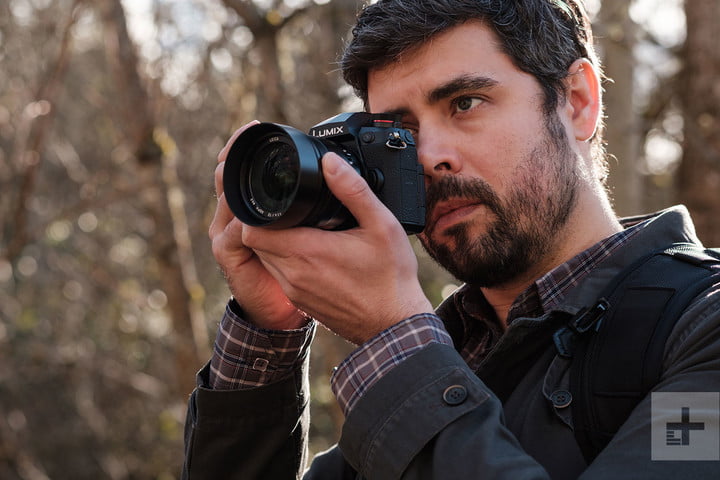
Why should you buy this: Pro-level features wrapped up in a compact system
Who’s it for: Enthusiasts who want class-leading photography features — and quite good video, too
How much will it cost: $1,700 (body only)
Why we picked the Panasonic Lumix DC-G9:
It took a while for Panasonic to catch up to Micro Four Thirds rival Olympus, but the Lumix G9 is a powerful mirrorless camera that can keep up with larger pro-level DSLRs. It features the best control layout of any MFT camera, the largest electronic viewfinder of just about any mirrorless camera, and a sturdy, weatherproof body that lets you take it anywhere.
It also offers an impressive in-body stabilization system that works in conjunction with stabilized lenses for a maximum of 6.5 stops of shake reduction. Its smaller, 20MP sensor may not match the image quality of the APS-C and full-frame competition on this list, but the Lumix G9 makes up for it with incredible speed. It can shoot up to 20 frames per second with continuous autofocus using the electronic shutter, and also offers both 4K and 6K photo modes for continuous, uninterrupted shooting at 60 and 30 fps, respectively. And if you need more resolution, the camera can merge an 80MP image from eight separate frames with its High Resolution mode.
Of course, it wouldn’t be a Panasonic without a great video mode, and the G9 doesn’t disappoint here, either. It may not offer the pro-level features of the GH5 and GH5S, but it can still shoot 4K video at up to 60 frames per second, and it doesn’t impose a recording time limit like most other hybrid cameras.
At around $1,700, there are many APS-C and even some full-frame competitors to be found at similar prices, so while the camera is excellent, the investment isn’t for every photographer. Interested in an even more compact and stylish MFT camera that won’t break the bank? We recommend taking a look at the Olympus OM-D E-M10 Mark III.
Read our Panasonic Lumix DC-G9 review
Panasonic Lumix GH5
The best mirrorless camera for recording video
Why should you buy this: The GH5 is a hybrid camera that’s can shoot both stills and video without cutting corners.
Who’s it for: Creatives who shoot both stills and video.
How much will it cost: $1,700 (body only)
Why we picked the Panasonic Lumix GH5:
All the cameras on this list shoot video, and most even shoot 4K. But in most cameras, video is a secondary focus. Not so with the Lumix GH5. Where many DSLRs and mirrorless cameras have short recording limits for 4K, the GH5 will happily continue shooting until the card fills up or the battery dies — and it boasts smooth-as-butter 60-fps 4K, to boot. Beyond that, it offers a number of video features targeting professional users, including 10-bit 4:2:2 recording, clean HDMI output, and an optional log gamma profile via paid firmware upgrade. (The recently released Lumix GH5S takes video quality to a new level, but the standard model remains the better choice for most users thanks to its 5-axis image stabilization.)
While video is a big selling point for the GH5, the camera can hold its own among other Micro Four Thirds shooters for still photos. The five-axis image stabilization plays a role for both videos and photos, the autofocus is quick, and still photos are as fast as 9 fps with continuous autofocus or 12 fps with focus locked on the first frame. The GH5 also has several Panasonic-exclusive features, including 4K and 6K photo modes where you can choose the focus point after the shot, merge several images together for a deeper depth of field, or shoot reduced-resolution still photos at 60 or 30 fps, respectively.
Like the hybrid photo-video capabilities, the GH5’s body feels more like a DSLR/mirrorless hybrid. It’s smaller than most DSLRs, but there are plenty of physical controls, a great electronic viewfinder, and dual SD card slots. While you can buy cameras with larger sensors for the same price, the GH5 has the best mix of photo and video options we’ve seen yet, and outclasses many cameras costing much more when it comes to pro video features.
Read our Panasonic Lumix GH55 review
Canon EOS M6
The mirrorless camera for beginners
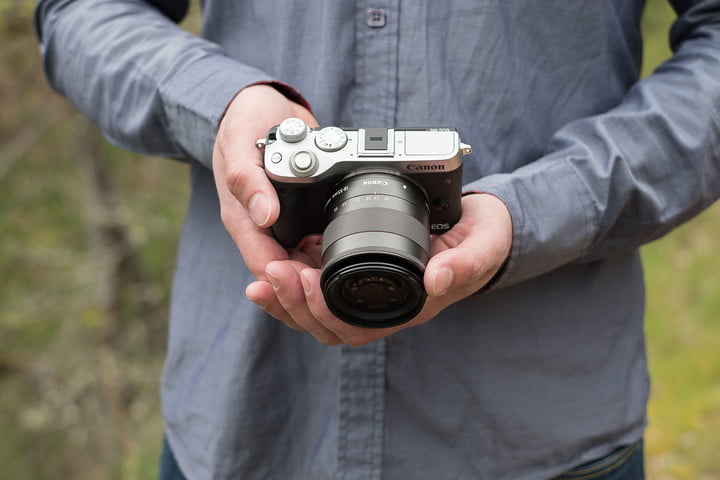
Why should you buy this: A beginner-friendly camera with a beginner-friendly price tag.
Who’s it for: First-time buyers jumping into mirrorless cameras
How much will it cost: $600 with an EF-M 15-45mm lens
Why we picked the Canon EOS M6:
Still reeling from the four-figure price points of the best mirrorless cameras? While the growth of the mirrorless ecosystem means there’s now a pro-level performer in every category packed full of incredible features, camera companies aren’t leaving entry-level users behind. The Canon EOS M6 is a beginner-friendly camera that you can pick up for around $600 with a lens. The newer Canon EOS M50 has more features, but the price point is a bit higher.
The M6 shares the same sensor as the pricier, more advanced EOS M5, which means image quality is identical to the higher-end model — and we always love to see budget cameras that don’t skimp on image quality. The build quality is also similar and feels solid and durable in the hand.
So if image quality and build are similar, what did the M6 give up to hit that price point? It ditches the electronic viewfinder of the M5, leaving only the LCD screen for composing your shot. Like the M5, there’s no 4K video, and since Canon was a bit late to the mirrorless game, there aren’t as many lens options compared to other brands. Canon’s new EOS M50 offers 4K for a similar price point, but only at 24 frames per second. The Fujifilm X-E3 is another lower-priced option that has an edge on the M6 is some areas, like its 4K/30 fps video mode, but it costs another $100 more.
Read our Canon EOS M6 review
How we test
Mirrorless cameras have come a long way since the first models, and nearly all are now capable of producing pleasing images. To find the best models, we factor in criteria such as image quality, speed and autofocus performance, low-light strength, video features, durability, and any unique aspects that help them one-up the competition.
Our selections are based on our long- and short-term testing; experience with earlier models; familiarity with the companies’ technologies; consultation with industry experts, fellow journalists, and users; online forums; lab results (such as DxO); and other third-party reviews. We look across the board — not just our own experiences — to find consensus on what we think are the best-performing cameras you can currently buy. We also look at list pricing to determine if a product is worth the cost.
The camera market evolves constantly, with manufacturers often introducing better models with new features. So, you can expect our picks to change over time. But don’t worry: The models you see here will be with you for some time, and if we anticipate there could be better models in the horizon, we will state that upfront to help you decide whether you should buy now or wait.
What is a mirrorless camera?
A mirrorless camera is a type of camera that uses interchangeable lenses, also called (to a lesser extent) a Compact System Camera. It’s related to the digital single lens reflex (DSLR) camera, but do not confuse the two as the same. DSLRs use mirrors to reflect light from the lens to the optical viewfinder (OVF). When the shutter button is pressed, a mirror flips up to allow light to hit the sensor.
Mirrorless cameras do away with the mirror system and OVF (hence the name), allowing for lighter and smaller designs (although professional models can be somewhat bulky and heavy). But like DSLRs, mirrroless cameras let you attach a variety of lenses and typically use larger sensors than point-and-shoot, fixed-lens cameras, which leads to superior image quality.
For more on the difference between DSLR, mirrorless, or point-and-shoot cameras, check out our guide here. We also have tips on how to buy a camera, and if you’re buying your first mirrorless camera, read up on how to select some lenses.
To learn more about the difference between the various sensors used by mirrorless cameras, read our explainer here.
